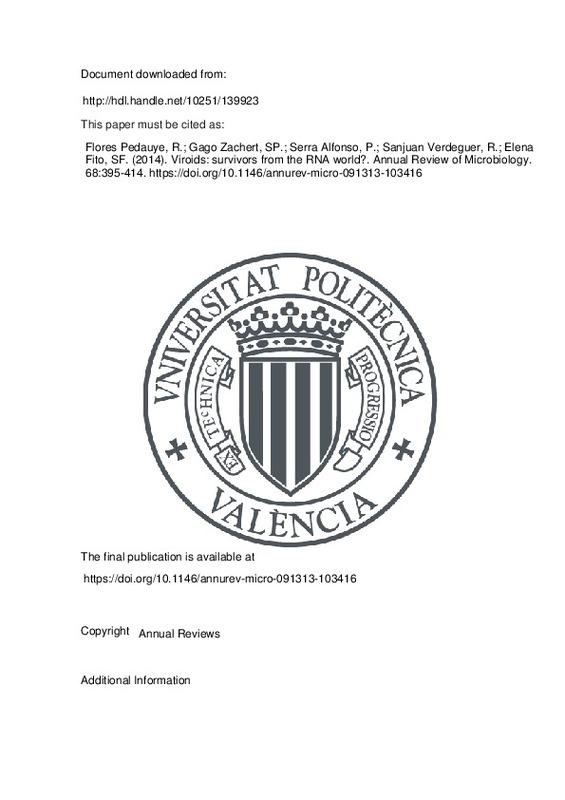JavaScript is disabled for your browser. Some features of this site may not work without it.
Buscar en RiuNet
Listar
Mi cuenta
Estadísticas
Ayuda RiuNet
Admin. UPV
Viroids: survivors from the RNA world?
Mostrar el registro sencillo del ítem
Ficheros en el ítem
| dc.contributor.author | FLORES PEDAUYE, RICARDO
|
es_ES |
| dc.contributor.author | Gago Zachert, Selma Persida
|
es_ES |
| dc.contributor.author | SERRA ALFONSO, PEDRO
|
es_ES |
| dc.contributor.author | Sanjuan Verdeguer, Rafael
|
es_ES |
| dc.contributor.author | ELENA FITO, SANTIAGO FCO
|
es_ES |
| dc.date.accessioned | 2020-04-01T07:15:24Z | |
| dc.date.available | 2020-04-01T07:15:24Z | |
| dc.date.issued | 2014 | es_ES |
| dc.identifier.issn | 0066-4227 | es_ES |
| dc.identifier.uri | http://hdl.handle.net/10251/139923 | |
| dc.description.abstract | [EN] Because RNA can be a carrier of genetic information and a biocatalyst, there is a consensus that it emerged before DNA and proteins, which eventually assumed these roles and relegated RNA to intermediate functions. If such a scenario¿the so-calledRNAworld¿existed,wemight hope to find its relics in our presentworld. The properties of viroids that make them candidates for being survivors of the RNA world include those expected for primitive RNA replicons: (a) small size imposed by error-prone replication, (b) high G + C content to increase replication fidelity, (c) circular structure for assuring complete replication without genomic tags, (d ) structural periodicity for modular assembly into enlarged genomes, (e) lack of protein-coding ability consistent with a ribosome-free habitat, and ( f ) replication mediated in some by ribozymes, the fingerprint of the RNA world. With the advent of DNA and proteins, those protoviroids lost some abilities and became the plant parasites we now know. | es_ES |
| dc.description.sponsorship | R.F. has received funding by grant BFU2011-28443 from Ministerio de Economia y Competititvidad (MINECO, Spain), R.S. by grants BFU2011-25271 (MINECO) and ERC-2011-StG-281191-VIRMUT (European Research Council), and S.F.E. by grant BFU2012-30805 (MINECO). P.S. has been supported by postdoctoral contracts from Generalitat Valenciana (APOSTD/2010, program VALi+d) and MINECO (program Juan de la Cierva). | es_ES |
| dc.language | Inglés | es_ES |
| dc.publisher | Annual Reviews | es_ES |
| dc.relation.ispartof | Annual Review of Microbiology | es_ES |
| dc.rights | Reserva de todos los derechos | es_ES |
| dc.subject | Viroid-like satellite RNAs | es_ES |
| dc.subject | Hepatitis delta virus | es_ES |
| dc.subject | Catalytic RNAs | es_ES |
| dc.subject | Hammerhead ribozymes | es_ES |
| dc.subject | Small noncoding RNAs | es_ES |
| dc.title | Viroids: survivors from the RNA world? | es_ES |
| dc.type | Artículo | es_ES |
| dc.identifier.doi | 10.1146/annurev-micro-091313-103416 | es_ES |
| dc.relation.projectID | info:eu-repo/grantAgreement/MICINN//BFU2011-28443/ES/VIROIDES: DOMINIOS ESTRUCTURALES, INICIACION DE LA TRANSCRIPCION, INTERACCION CON PROTEINAS ARGONAUTAS DEL HUESPED, Y TASAS DE MUTACION/ | es_ES |
| dc.relation.projectID | info:eu-repo/grantAgreement/EC/FP7/281191/EU/Variability in the mutation rate of RNA viruses/VIRMUT/ | es_ES |
| dc.relation.projectID | info:eu-repo/grantAgreement/MINECO//BFU2012-30805/ES/EVOLUTIONARY SYSTEMS VIROLOGY: EPISTASIS AND THE RUGGEDNESS OF ADAPTIVE LANDSCAPES, MUTATIONS IN REGULATORY SEQUENCES, AND THE HOST DETERMINANTS OF VIRAL FITNESS/ | es_ES |
| dc.relation.projectID | info:eu-repo/grantAgreement/MINECO//BFU2011-25271/ES/VARIABILIDAD Y EVOLUCION DE LAS TASAS DE MUTACION EN VIRUS DE RNA/ | es_ES |
| dc.relation.projectID | info:eu-repo/grantAgreement/GVA//APOSTD%2F2010/ | es_ES |
| dc.rights.accessRights | Abierto | es_ES |
| dc.contributor.affiliation | Universitat Politècnica de València. Instituto Universitario Mixto de Biología Molecular y Celular de Plantas - Institut Universitari Mixt de Biologia Molecular i Cel·lular de Plantes | es_ES |
| dc.description.bibliographicCitation | Flores Pedauye, R.; Gago Zachert, SP.; Serra Alfonso, P.; Sanjuan Verdeguer, R.; Elena Fito, SF. (2014). Viroids: survivors from the RNA world?. Annual Review of Microbiology. 68:395-414. https://doi.org/10.1146/annurev-micro-091313-103416 | es_ES |
| dc.description.accrualMethod | S | es_ES |
| dc.relation.publisherversion | https://doi.org/10.1146/annurev-micro-091313-103416 | es_ES |
| dc.description.upvformatpinicio | 395 | es_ES |
| dc.description.upvformatpfin | 414 | es_ES |
| dc.type.version | info:eu-repo/semantics/publishedVersion | es_ES |
| dc.description.volume | 68 | es_ES |
| dc.relation.pasarela | S\266233 | es_ES |
| dc.contributor.funder | Generalitat Valenciana | es_ES |
| dc.contributor.funder | European Commission | es_ES |
| dc.contributor.funder | Ministerio de Economía y Competitividad | es_ES |
| dc.contributor.funder | Ministerio de Ciencia e Innovación | es_ES |







![[Cerrado]](/themes/UPV/images/candado.png)

